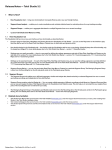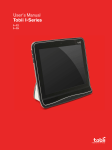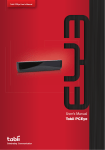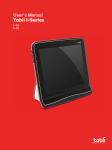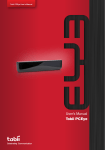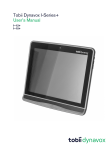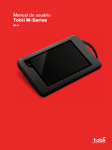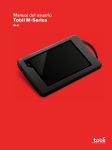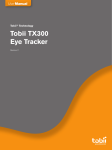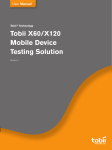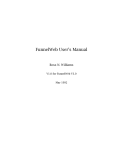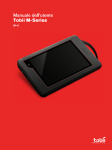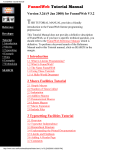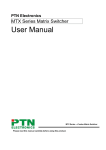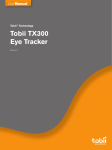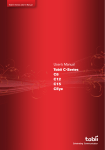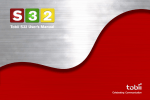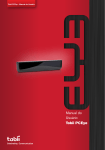Download User`s Manual Tobii PCEye Go
Transcript
U se r ’s Ma n u a l Tob ii PCEye Go Tobii PCEye Go User’s manual Version 2.5 06/2014 All rights reserved. © Tobii Technology AB The information contained in this document is proprietary to Tobii Technology. Any reproduction in part or whole without prior written authorization by Tobii Technology is prohibited. Products that are referred to in this document may be either trademarks and/or registered trademarks of the respective owners. The publisher and the author make no claim to these trademarks. While every precaution has been taken in the preparation of this document, the publisher and the author assume no responsibility for errors or omissions, or for damages resulting from the use of information contained in this document or from the use of programs and source code that may accompany it. In no event shall the publisher and the author be liable for any loss of profit or any other commercial damage caused or alleged to have been caused directly or indirectly by this document. Content subject to change without notice. Please check Tobii web site www.tobii.com for updated versions of this document. The following products are protected by U.S. Patent 7,572,008: • Tobii PCEye Go You can locate the Type of Tobii PCEye Go device on the label on the back side. Table of Contents 1 In t r o du ct io n . . . . . . . . . . . . . . . . . . . . . . . . . . . . . . . . . . . . . . . . . . . . . . . . . . . . . . . . . . . . . . . . . . . . . . . . . . . . . . . . . . . . . . . . . . . . . . . . . . . . . . . . . . . . . . . . . . . . . . . . . . . . . . . . . . 1 1.1 1.2 1.3 1.4 2 Safety ............................................................................................................................................ 3 2.1 2.2 2.3 2.4 2.5 2.6 2.7 2.8 3 Mounting Warning ..................................................................................................................3 Emergency Warning ...............................................................................................................3 Infrared Warning ....................................................................................................................3 Epilepsy Warning ...................................................................................................................3 Magnetic Field Warning ..........................................................................................................3 Child Safety...........................................................................................................................4 Do not Open the Tobii PCEye Go .............................................................................................4 Gaze Interaction .....................................................................................................................4 Ge t t in g S t ar t e d . . . . . . . . . . . . . . . . . . . . . . . . . . . . . . . . . . . . . . . . . . . . . . . . . . . . . . . . . . . . . . . . . . . . . . . . . . . . . . . . . . . . . . . . . . . . . . . . . . . . . . . . . . . . . . . . . . . . . . . . . . . . 5 3.1 3.2 3.3 3.4 4 Explanation of Admonitions ......................................................................................................1 Symbols and Markings ............................................................................................................1 Intended Use .........................................................................................................................1 Package Contents ..................................................................................................................2 The Tobii PCEye Go Installation Guide ......................................................................................5 Mounting the Tobii PCEye Go to your Monitor/Laptop .................................................................5 The Tobii PCEye Go Configuration Guide..................................................................................6 Software Updates ..................................................................................................................8 U sin g t h e T o bii P C Eye Go . . . . . . . . . . . . . . . . . . . . . . . . . . . . . . . . . . . . . . . . . . . . . . . . . . . . . . . . . . . . . . . . . . . . . . . . . . . . . . . . . . . . . . . . . . . . . . . . . . . . . . . . . . . 9 4.1 4.2 Positioning ............................................................................................................................9 4.1.1 Track Box ...............................................................................................................9 4.1.2 Track Status Viewer...............................................................................................10 4.1.2.1 Showing Track Status .......................................................................10 4.1.3 Positioning Guide..................................................................................................10 Using Windows Control ........................................................................................................11 4.2.1 Windows Control Type ..........................................................................................11 4.2.2 Starting and Disabling Tobii Windows Control...........................................................12 4.2.3 Using Gaze Selection ............................................................................................12 4.2.3.1 Gaze Selection Taskbar ....................................................................12 4.2.3.2 Task Buttons....................................................................................14 4.2.3.3 Functions Overlay in Windows 7 ........................................................15 4.2.3.4 Functions Overlay in Windows 8 ........................................................15 4.2.3.4.1 Snap Window/Close App ...........................................17 4.2.3.4.2 To Snap More Apps ..................................................19 4.2.3.5 Selection Methods — Gaze and Switch...............................................21 4.2.3.5.1 Sticky Tasks & Default Left Click / Tap for Switch .....................................................................21 4.2.3.5.2 Activating a Task with a Keyboard button instead of a Switch .....................................................................22 4.2.3.6 Gaze Keyboard ................................................................................22 4.2.3.7 Gaze Selection in Combination with Region Based Keyboards ...............23 4.2.4 Using Mouse Emulation..........................................................................................23 4.2.4.1 Placing the Mouse Emulation Menu.....................................................24 4.2.4.2 Clicking with Windows Control in Mouse Emulation Mode .....................24 4.2.4.3 Magnifying with Windows Control in Mouse Emulation Mode .................24 4.2.4.4 Selecting Mouse Emulation Functions .................................................24 4.3 4.4 5 T o bii Ga z e In t e r a c t io n S e t t in gs . . . . . . . . . . . . . . . . . . . . . . . . . . . . . . . . . . . . . . . . . . . . . . . . . . . . . . . . . . . . . . . . . . . . . . . . . . . . . . . . . . . . . . . . . . . . . . . . 28 5.1 5.2 5.3 5.4 5.5 5.6 5.7 6 Accessing the Tobii Gaze Interaction Settings..........................................................................28 Calibration...........................................................................................................................28 5.2.1 Starting Calibration................................................................................................29 5.2.2 Interrupting Calibration...........................................................................................29 5.2.3 Customizing Active Eye..........................................................................................29 5.2.4 Improving Calibration Point(s) .................................................................................30 5.2.5 Removing Calibration Point(s) .................................................................................31 5.2.6 Customizing the Calibration ....................................................................................31 5.2.7 Customizing the Calibration Area.............................................................................32 Interaction ...........................................................................................................................33 User Profile..........................................................................................................................34 5.4.1 Creating a New Profile ...........................................................................................34 5.4.2 Selecting Current User Profile.................................................................................35 5.4.3 Deleting a Profile ...................................................................................................35 Windows Control .................................................................................................................35 5.5.1 Auto Start ............................................................................................................35 5.5.2 Windows Control Type ..........................................................................................35 5.5.2.1 Gaze Selection ................................................................................36 5.5.2.2 Mouse Emulation..............................................................................36 5.5.2.2.1 Mouse Control Speed ................................................36 5.5.2.2.2 Magnifier Size and Zoom ............................................37 5.5.2.2.3 Auto Switch from Right to Left Click.............................37 5.5.2.2.4 Turn off Scroll Functionality .........................................37 5.5.2.2.5 Custom Cursors........................................................37 5.5.2.2.6 Hide Menu ................................................................37 System Settings ...................................................................................................................38 5.6.1 System Off-Screen Menu .......................................................................................38 5.6.2 Positioning Guide..................................................................................................38 System Information ...............................................................................................................39 5.7.1 Upgrade Eye Tracker Firmware ...............................................................................39 Ga z e S e le c t io n S e t t in gs . . . . . . . . . . . . . . . . . . . . . . . . . . . . . . . . . . . . . . . . . . . . . . . . . . . . . . . . . . . . . . . . . . . . . . . . . . . . . . . . . . . . . . . . . . . . . . . . . . . . . . . . . . . . 40 6.1 6.2 6.3 7 4.2.4.5 Pausing Windows Control in Mouse Emulation Mode............................25 4.2.4.6 Scrolling with Windows Control in Mouse Emulation Mode ....................25 Pause/Resume Gaze Interaction.............................................................................................26 Tobii PCEye Update Notifier ..................................................................................................26 The General Settings Tab ......................................................................................................40 The Keyboard Settings Tab ....................................................................................................41 The Taskbar Settings Tab ......................................................................................................41 6.3.1 Maximize Left Click/Tap ..........................................................................................42 P r o du c t C a r e . . . . . . . . . . . . . . . . . . . . . . . . . . . . . . . . . . . . . . . . . . . . . . . . . . . . . . . . . . . . . . . . . . . . . . . . . . . . . . . . . . . . . . . . . . . . . . . . . . . . . . . . . . . . . . . . . . . . . . . . . . . . . . 43 7.1 7.2 7.3 7.4 Temperature & Humidity ........................................................................................................43 7.1.1 General Use .........................................................................................................43 7.1.2 Transportation and Storage ....................................................................................43 Cleaning .............................................................................................................................43 Transporting the Tobii PCEye Go ...........................................................................................43 Disposing of the Tobii PCEye Go............................................................................................43 A ppe n dix A S u ppo r t a n d W a r r a n t y . . . . . . . . . . . . . . . . . . . . . . . . . . . . . . . . . . . . . . . . . . . . . . . . . . . . . . . . . . . . . . . . . . . . . . . . . . . . . . . . . . . . . . . . . . . . . . . . 44 A ppe n dix B C o m plia n c e In f o r m a t io n . . . . . . . . . . . . . . . . . . . . . . . . . . . . . . . . . . . . . . . . . . . . . . . . . . . . . . . . . . . . . . . . . . . . . . . . . . . . . . . . . . . . . . . . . . . . . 45 A ppe n dix C T h ir d P a r t y A c c e sso r ie s . . . . . . . . . . . . . . . . . . . . . . . . . . . . . . . . . . . . . . . . . . . . . . . . . . . . . . . . . . . . . . . . . . . . . . . . . . . . . . . . . . . . . . . . . . . . . 47 A ppe n dix D T e c h n ic a l S pe c if ic a t i o n s .. . . . . . . . . . . . . . . . . . . . . . . . . . . . . . . . . . . . . . . . . . . . . . . . . . . . . . . . . . . . . . . . . . . . . . . . . . . . . . . . . . . . . . . . . . . 48 1 Introduction Thank you for purchasing a Tobii PCEye Go device from Tobii Technology! To ensure the optimal performance of this product, please take the time to read this manual carefully. 1.1 Explanation of Admonitions In this manual we use three (3) levels of admonitions as follows: Is used for notifying the user of something important or of something that needs special attention. Is used to inform of something that could cause harm to, or malfunction of, the equipment. Is used to inform of something where there could conceivably be a risk of harm to the user if the Warning is ignored. 1.2 Symbols and Markings This appendix provides information about the symbols that are used on the Tobii PCEye Go, its parts, accessories or packaging. S ym bo l o r Ma r kin gs De sc ript ion Consult User´s Manual Dispose of in accordance with your country's requirements. CE is the abbreviation of the European Communities and this mark tells customs officials in the European Union that the product complies with one or more of the EC Directives This mark is a certification mark employed on electronic products manufactured or sold in the United States which certifies that the electromagnetic interference from the device is under limits approved by the Federal Communications Commission. IC 1.3 IC is the abbreviation of the Industry Canada and this mark tells customs officials in Canada that the product complies with one or more of the Canadian standards. Intended Use The Tobii PCEye Go is a clip-on eye tracker that lets you access and control your computer using only your eyes only. Simply look at the computer screen and select commands by blinking, dwelling or clicking a switch. Alternatively, control the mouse cursor with your eye movements The Tobii PCEye Go fits snuggly on your laptop, docks under retail computer screens and can also be inserted into a Tobii EyeMobile bracket and mounted to certain Tablets. The Tobii PCEye Go gives you a fast, accurate, and hands free way of accessing the many ways a computer can enrich your life. You can pursue your interests and education, express yourself artistically, stay entertained as well as control your TV, DVD, lights and other devices in your surroundings1. 1. Requires an Environmental Control Unit (ECU) and separate senders and receivers, not included with the Tobii PCEye Go. Tobii PCEye GoUser’s manual v.2.5 - en-US 1 Introduction 1 It is also valuable to help you to re-enter the workplace, to stay in touch with friends and family, to meet new people and to interact with your children. The Tobii PCEye Go is intended to be used in an indoor environment. For more information about Screen Sizes, see Appendix D Technical Specifications. F i g u r e 1 . 1 Tobii PCEye Go Do not cover the front of the Tobii PCEye Go in any way (with decorations, Post-Its, etc.) as Gaze Interaction will be compromised. Using an antivirus program is strongly recommended. 1.4 • • • • • • • Package Contents Tobii PCEye Go USB stick with installation script, manuals, and necessary software Carrying Case Magnetic Mounting Plate (2 pcs) for Tobii PCEye Go Mounting Instruction USB Extension Cable Cleaning Wipe Only use the items included in the Tobii PCEye Go package, those described in the product documentation and other approved Tobii Accessories in conjunction with the Tobii PCEye Go. 2 1 Introduction Tobii PCEye Go User’s manual v.2.5 - en-US 2 Safety The Tobii PCEye Go has been tested and approved as compliant to all the Specifications and Standards listed in the Appendix B Compliance Information, page 45 in this manual and in the Appendix D Technical Specifications, page 48 – including, but not limited to, the Medical Device Directive (MDD) 93/42/EEC.Nevertheless, in order to ensure safe operation of your Tobii PCEye Go device, there are a few safety warnings to bear in mind: 2.1 Mounting Warning The Tobii PCEye Go should be mounted according to MANUFACTURER instructions of approved mounts. Tobii Technology or its agents are not liable for damage or injuries to a person or its property due to a Tobii PCEye Go falling from a mounted configuration. The mounting of a Tobii PCEye Go is done entirely at the user’s own risk. The double sided tape supplied with the adhesive Magnetic Mounting Plates is designed to permanently attach the bracket to the monitor/laptop. Attempting to remove the bracket after attaching it using the supplied tape can result in damage both to the monitor/laptop and the bracket. Do not lick the tape or place any part of the tape or Magnetic Mounting Plate in one's mouth. Do not mount the Tobii PCEye Go on monitors positioned above the head or face of a users unless using a dedicated "fixed mounting" solution. 2.2 Emergency Warning Be aware that due to the low, but possible, risk of failure, the Tobii PCEye Go should not be relied upon exclusively as an audio communications, or an environmental control, device in emergencies, as well as in dangerous, or otherwise important, situations. Do not rely on the device for emergency calls or banking transactions. We recommend having multiple ways to communicate in emergency situations. Banking transactions should only be carried out with a system recommended by, and approved according to the standards of, your bank. 2.3 Infrared Warning When activated, the Tobii PCEye Go emits pulsed infrared (IR) light. Certain medical devices are susceptible to disturbance by IR light and/or radiation. Do not use the Tobii PCEye Go when in the vicinity of such susceptible medical devices as their accuracy or proper functionality could be inhibited. 2.4 Epilepsy Warning Some people with P h o t o s e n si t i v e E p i l e p s y are susceptible to epileptic seizures or loss of consciousness when exposed to certain flashing lights or light patterns in everyday life. This may happen even if the person has no medical history of epilepsy or has never had any epileptic seizures. A person with Photosensitive Epilepsy would also be likely to have problems with TV screens, some arcade games, and flickering fluorescent bulbs. Such people may have a seizure while watching certain images or patterns on a monitor, or even when exposed to the light sources of an eye tracker. It is estimated that about 3-5% of people with epilepsy have this type of Photosensitive Epilepsy. Many people with Photosensitive Epilepsy experience an "aura" or feel odd sensations before the seizure occurs. If you feel odd during use, move your eyes away from the eye tracker. 2.5 Magnetic Field Warning The Tobii PCEye Go Magnetic Mounting Plates contains magnets. Magnetic fields may interfere with the function of cardiac pacemakers and implantable cardioverter-defibrillators. As a general rule, maintain a minimum distance of 6 inches (15 centimeters) between any item with magnets and your heart device. The magnets can also shut off the monitor on a laptop if the laptop is equipped with a magnetic sensor to switch off the monitor when closing the laptop. If this happens, shut of the sensor on the laptop. Tobii PCEye GoUser’s manual v.2.5 - en-US 2 Safety 3 2.6 Child Safety The Tobii PCEye Go is an advanced computer system and electronic device. As such it is composed of numerous separate, assembled parts. In the hands of a child certain of these parts have the possibility of being separated from the device, possibly constituting a choking hazard or another danger to the child. Young children should not have access to, or the use of, the device without parental or guardian supervision. 2.7 Do not Open the Tobii PCEye Go Non-compliance will result in loss of Warranty! There are no user serviceable components inside. Contact Tobii Support if your Tobii PCEye Go is not working properly. 2.8 Gaze Interaction Some people may experience a certain amount of fatigue (due to intentional eye focusing and hard concentration) or even a dryness of the eyes (due to less frequent blinking) when first getting used to Gaze Interaction. If you are experiencing fatigue or dry eyes start off slowly and limit the length of your Gaze Interaction sessions to your comfort level. Remoisturizing eye drops can be helpful to combat dryness. 4 2 Safety Tobii PCEye Go User’s manual v.2.5 - en-US 3 Getting Started To start using Gaze Interaction, you must first install the necessary software and drivers from the included USB-stick, mount the Tobii PCEye Go device to its Magnetic Mounting Plates and attach it properly to your device. Install the software FIRST before connecting the Tobii PCEye Go device to your computer. Works with PC computers running on a Windows operating system ONLY (Windows Vista, Windows 7 or Window 8). Be aware that there is no virus protection included with the Tobii PCEye Go Software. Be sure to have proper virus protection installed on your computer to safeguard against malfunctions. The Installation Guide will install the necessary software and drivers for the Tobii PCEye Go. Will only be run once on each device a Tobii PCEye Go is to be attached to. The Configuration Guide will assist in configuration of the Tobii PCEye Go. Can be run several times to change the configuration for the Tobii PCEye Go on the device (such as to change monitors and/or screen sizes). 3.1 The Tobii PCEye Go Installation Guide The Tobii PCEye Go I n s t a l l a t i o n Gu i d e will help you to get started using Gaze Interaction with your computer. It will guide you through the installation of the necessary software for the Tobii PCEye Go and provide Licensing information 1. Insert the included USB-stick into your computer’s USB port. 2. Open the USB-stick directory. 3. Run PCEye.exe 4. Follow the instructions within the I n st a l l a t i o n Gu i d e , selecting N e x t to proceed. 3.2 Mounting the Tobii PCEye Go to your Monitor/Laptop Wait 1 h o u r for the glue on the Magnetic Mounting Plate to s e t before attaching the Tobii PCEye Go to the Magnetic Mounting Plate on the screen / monitor. To mount the Tobii PCEye Go properly to your computer follow the instructions in the software I n s t a l l a t i o n Gu i d e (also present in the software C o n f i g u r a t i o n G u i d e ) and use the included T o b i i P C Ey e G o Mo u n t i n g G u i d e . F i g u r e 3 . 1 Attaching the Magnetic Mounting Plate Wait 1 h o u r for the glue on the Magnetic Mounting Plate to s e t before attaching the Tobii PCEye Go to the Magnetic Mounting Plate on the screen / monitor. Tobii PCEye GoUser’s manual v.2.5 - en-US 3 Getting Started 5 If the included extension cable for the Tobii PCEye Go is too short, use a “Powered USB” Hub or Port for best performance. 5. After you have mounted the Tobii PCEye Go properly, attach the USB connector to your computer. 6. The Tobii PCEye Go Configuration Guide will open automatically. 3.3 The Tobii PCEye Go Configuration Guide Upon restarting your computer after running the Tobii PCEye Go I n s t a l l a t i o n G u i d e , attaching the Magnetic Mounting Plate(s) and Tobii PCEye Go to your computer and connecting the USB cable, the Tobii PCEye Go C o n f i g u r a t i o n G u i d e will open automatically. The Configuration Guide will help you to get started using Gaze Interaction on your computer. It will assist you in the areas of: • • • • Monitor choice and screen size Positioning Calibration Settings Follow the instructions on each page of the C o n f i g u r a t i o n G u i d e , select N e x t to move to the next page of the Guide. 6 3 Getting Started Tobii PCEye Go User’s manual v.2.5 - en-US Pay particular attention to the S c r e e n page and the C a l i b r a t i o n page of the Configuration Guide. In both cases you must complete the information, or tasks, requested of you before you are able to select N e x t . On the S c r e e n page be sure to measure the actual blue lines making up the triangle on the screen with the included ruler on the side of the Tobii PCEye Go Mounting Guide and fill in their numbers in the spaces provided. Then select Save. DO NOT attempt to measure the physical screen size of your computer. The numbers of the measured lines from the triangle will be extrapolated into the size of the physical screen by the software. On the C a l i b r a t i o n page, you must calibrate before moving on to the next page. Follow the instructions and select C a l i b r a t e . Without calibration, you will be unable to finish the C o n f i g u r a t i o n G u i d e and Gaze Interaction will not work properly on your computer. • Select Finish on the final page of the C o n f i g u r a t i o n G u i d e and your settings and configurations will be saved for future use. The C o n f i g u r a t i o n Gu i d e will automatically launch if configuration changes to your system have been detected. All future settings, profile control, and calibrations will be controlled by, and can be accessed from, T o b i i G a z e I n t e r a c t i o n S e t t i n g s (see 4 Using the Tobii PCEye Go, page 9 for information about T o b i i G a z e I n t e r a c t i o n S e t t i n g s ) Tobii PCEye GoUser’s manual v.2.5 - en-US 3 Getting Started 7 3.4 Software Updates To check for software updates for the Tobii PCEye Go, please use the Tobii PCEye Update Notifier, see 4.4 Tobii PCEye Update Notifier , page 26 for more information, or visit the Tobii website: http://www.tobii.com 8 3 Getting Started Tobii PCEye Go User’s manual v.2.5 - en-US 4 4.1 Using the Tobii PCEye Go Positioning X cm / inches F i g u r e 4 . 1 Positioning The mounted Tobii PCEye Go attached to its Magnetic Mounting Plates and to your device is designed to work optimally when it is parallel to the user’s eyes at a distance from about 45 — 90 cm (18 to 35 inches) for Tobii PCEye Go, see Figure 4.1 Positioning, page 9 or Figure 4.2 Positioning when Users Leaning Sideways or Those Lying Down, page 9. X cm / inches F i g u r e 4 . 2 Positioning when Users Leaning Sideways or Those Lying Down This means that for those users leaning sideways or those lying down the Tobii PCEye Go with monitor and computer device also needs to be tilted in order to keep the users eyes parallel to the screen and at the optimal distance, see Figure 4.2 Positioning when Users Leaning Sideways or Those Lying Down, page 9. Make sure the user is placed comfortably in relation to the optimal positioning of, and distance from, the unit. Be aware also that the user’s comfort, as well as the Gaze Interaction performance, will be enhanced if the sun is not shining directly on the screen or into the user’s eyes. The optimal distance that a user should be from the Tobii PCEye Go mounted on a monitor/laptop differs depending on the size of the screen. The user should be positioned at the optimal distance to allow for the best possible Gaze Interaction. Generally, the larger the size of the screen, the greater the distance the user should be from the Eye Tracker / Screen combination for optimal Gaze Interaction. Smaller than a 10 inch screen and larger than a 27 inch screen should not be used for optimal Gaze Interaction, for more information see Appendix D Technical Specifications, page 48. 4.1.1 Track Box The Tobii PCEye Go allows for extensive Freedom of Head Movement. Once the Tobii PCEye Go is properly calibrated and placed in front of the user, no further adjustments are required. The Tobii PCEye Go produces an industry leading sized track box with the approximate dimensions of 30 cm × 20 cm × 20 cm / 11.8 in × 7.9 in × 7.9 in (Width × Height × Depth). The Track Box is an invisible box positioned approximately 60 cm (23.5 in) straight out from a point just above the middle of the screen. Tobii PCEye GoUser’s manual v.2.5 - en-US 4 Using the Tobii PCEye Go 9 At 70 cm (27.5 in) the Tobii PCEye Go allows for lateral Freedom of Head Movement in an area of about 50 × 36 cm (20 × 14 in). In order to function properly for Gaze Interaction the user needs at least one eye in the track box at all times. 4.1.2 Track Status Viewer Use the Track Status viewer (see 4.1.2.1 Showing Track Status, page 10 for more information on how to open the Track Status viewer) to help determine the optimal height and horizontal positioning for Gaze Interaction with the Tobii PCEye Go. • • • Ideally, the two dots that represent the user’s eyes should be in the middle of the Track Status viewer. Use the distance meter on the right hand side of the Track Status viewer to determine the optimal distance the user should be from the Tobii PCEye Go. The white triangle in the distance meter should hover near the center, within the green, when the optimal distance from the Tobii PCEye Go is reached. For information about calibration of the Tobii PCEye Go see 5.2 Calibration, page 28. Also check the lighting conditions, related to what is mentioned above, when calibrating. 4.1.2.1 Showing Track Status The track status viewer is a window/dialog where you can verify that the Gaze Interaction recognizes your eyes and that you are well positioned in front of the device. Open the track status viewer in one of the following ways: • Open T o b i i Ga z e I n t e r a c t i o n S e t t i n g s > C a l i b r a t i o n and select the T r a c k s t a t u s button. • Right-click (long-hold finger on icon for touch screen right clicking) on the T o b i i G a z e I n t e r a c t i o n S e t t i n g s icon, in the Notification area and select S h o w t r a c k s t a t u s . 4.1.3 , Positioning Guide For extra assistance in positioning, there is a P o s i t i o n i n g g u i d e that will show itself automatically in the bottom-right corner of your monitor. The P o s i t i o n i n g g u i d e is a visual guide that combines the function of the Track Status viewer with six different image based instructions to help the user with correct positioning. 10 4 Using the Tobii PCEye Go Tobii PCEye Go User’s manual v.2.5 - en-US The 6 instructions direct the user to: 1. Move head down. 2. Move head up. 3. Move head to the right. 4. Move head to the left. 5. Move head closer to the monitor. 6. Move head farther away from the monitor Move head closer to the monitor. Move head to the right. The P o s i t i o n i n g g u i d e will automatically disappear when the user’s positioning is improved in the way that is directed by the guide. Some users may not want the P o s i t i o n i n g g u i d e to pop up every time their eyes leave optimal positioning. To turn On or Off the automatic P o s i t i o n i n g g u i d e , see 5.6 System Settings, page 38 4.2 Using Windows Control Windows Control allows you to access the desktop and all applications of your Windows computer with Gaze Interaction. 4.2.1 Windows Control Type Windows Control can be used in two different modes • • Gaze Selection Mouse Emulation To select which type of Windows Control you wish to use and to customize Windows Control: • • Open T o b i i Ga z e I n t e r a c t i o n S e t t i n g s > W i n d o w s C o n t r o l , see 5.5 Windows Control, page 35 Select your preferred type of Windows Control under W i n d o ws C o n t r o l T y p e Tobii PCEye GoUser’s manual v.2.5 - en-US 4 Using the Tobii PCEye Go 11 4.2.2 Starting and Disabling Tobii Windows Control To start Windows Control, right-click on the T o b i i G a z e I n t e r a c t i o n S e t t i n g s icon, En able W in do ws C o n t r o l. , in the Notification area and select Or Double-click on the T o b i i W i n d o w s C o n t r o l shortcut on the desktop, , This will immediately start Windows Control. To disable Windows Control, right-click on the T o b i i G a z e I n t e r a c t i o n S e t t i n g s icon, Disa ble W in do ws C o n t r o l. , in the Notification area and select You can also start Windows Control from Tobii Communicator or alternative communication software, which has implemented the functions provided by the Tobii Eye Control SDK A uto sta rt • • 4.2.3 Open T o b i i Ga z e I n t e r a c t i o n S e t t i n g s > W i n d o w s C o n t r o l . Check the A u t o s t a r t wi n d o ws c o n t r o l a t b o o t check box if you want Windows Control to auto start when the Tobii Gaze Interaction Software starts. Using Gaze Selection The Gaze Selection mode of Windows Control makes it possible for the user to control a standard Windows desktop operating system with a two step selection method which reduces the risks of unwanted clicks. It also prevents the following of the mouse cursor with your gaze as opposed to the controlling of it (there is no floating mouse cursor in Gaze Selection). 1. The first step is to select the desired Task from the docked Taskbar by looking at it. 2. The second step is to look at the desired portion of the screen (or icon on the screen) where you want to execute the Task. An automatic zoom function is enabled, ending in the selection of the icon or execution of the task. All functions in Gaze Selection are Touch and Mouse enabled which makes it easier for a Caregiver or Assistant to help the user if needed. The Caregiver or Assistant can select a Function/Task or change the settings for the user much easier. 4.2.3.1 Gaze Selection Taskbar At the top of the Gaze Selection Taskbar there is a Track Status viewer. It allows you to verify that the eye tracker recognizes your eyes and that you are well positioned in front of the device. The Task Buttons in the Gaze Selection Taskbar can be in three different modes as shown in Figure 4.3 The Modes for the Gaze Selection Taskbar, page 13. • • N o r m a l ( U n s e l e c t e d ) - No Task Button for Gaze Selection is chosen. P r i m a r y S e l e c t i o n ( B l u e / b l a c k) - The marked Task Button is selected and the Task will be executed after the automatic zoom when the user looks at the desired position on the screen or icon on it. If the selection method is set to Switch in the Gaze Selection Settings Dialog, the chosen Task Button will still remain active after executing the Task. The Functions Overlay Task will not perform any zooming. When selecting Functions Overlay with Primary Selection, the Functions Areas/Commands will be active but not visible. • 12 S e c o n d a r y S e l e c t i o n ( B l u e / wh i t e ) - Same as P r i m a r y S e l e c t i o n but with a higher precision. P r i m a r y S e l e c t i o n means that the zoom will progress deeper before the final execution of the Task, making the desired portion of the screen bigger and easier to select within. Activate this mode by resting your gaze on the Task Button until the color changes according to the image below. 4 Using the Tobii PCEye Go Tobii PCEye Go User’s manual v.2.5 - en-US The Functions Overlay Task will not perform any zooming. When selecting Functions Overlay with Secondary Selection, the Functions will be active and the areas of each Function will be visible to the user. In Windows 8 the colors on the Taskbar will adapt to Windows settings. The Functions Overlay will not perform any zoom, some other tasks won't either in some situations (scroll, settings, keyboard). Normal Track Status Track Status Gaze Scroll Gaze Scroll Left Click / Tap Left Click / Tap Functions Overlay Functions Overlay Double Click Double Click Right Click Right Click Gaze Drag & Drop Gaze Drag & Drop Gaze Keyboard Gaze Keyboard Settings Settings Primary Selection Secondary Selection F i g u r e 4 . 3 The Modes for the Gaze Selection Taskbar Tobii PCEye GoUser’s manual v.2.5 - en-US 4 Using the Tobii PCEye Go 13 4.2.3.2 Task Buttons Ta sk But ton A ctio n De sc ript io n Gaze Drag & Drop Task that performs two "clicks", where the first one represents the starting position for the drag and the second the drop position (to move objects or select areas). • • • • • Gaze Scroll Select the Task Look at the object you want to move or the starting point for the area selection Execute the Gaze Selection (first "click") by Switch or Gaze Look immediately at the drop position for the object or end point for the area selection. Execute the second "click" by Switch or Gaze Task that, if performed on a scrollable window, enables a gaze-controlled way to scroll the page • • • • • • • • Select the Task Look at any scrollable area and hold your gaze, the Gaze Scroll icon will appear where you looked Look above the icon to scroll up Look below the icon to scroll down Look to the left of the icon to scroll left Look to the right of the icon to scroll right While scrolling, look back at the icon (on the screen, not the Taskbar icon) to toggle between up/down or left/right Look back at the Gaze Selection Taskbar (or outside of the screen) to end scrolling Use the Gaze Scroll Task to scroll vertically and horizontally in Modern UI apps and the Modern UI Windows Start Screen. Left Click / Tap Task that performs a single left-click, or for touch based devices, the equivalent of a single finger Tap. When in Switch mode Left CLick / Tap is Default on and Sticky" (see 4.2.3.5.1 Sticky Tasks & Default Left Click / Tap for Switch, page 21) Functions Overlay Task that activates the Functions Overlay. Primary Selection activates the Functions Overlay. Secondary Selection activates the Functions Overlay and makes it (and its individual Functions and areas) visible over the top of anything else on the screen to assist in selecting them. The individual Functions available on the Functions Overlay are different for Windows 7 (see 4.2.3.3 Functions Overlay in Windows 7, page 15) and Windows 8 (see 4.2.3.4 Functions Overlay in Windows 8, page 15). Right Click Task that performs a single right-click Double Click Task that performs a double left-click. When in Switch mode Double Click is a "sticky Task" (see 4.2.3.5.1 Sticky Tasks & Default Left Click / Tap for Switch, page 21) Gaze Keyboard Task that opens an on-screen Gaze enabled keyboard for Gaze typing Settings Task that opens the Gaze Selection Settings Dialog For more information, see 6 Gaze Selection Settings, page 40 14 4 Using the Tobii PCEye Go Tobii PCEye Go User’s manual v.2.5 - en-US 4.2.3.3 Functions Overlay in Windows 7 When selecting the Functions Overlay with P r i m a r y S e l e c t i o n , the Functions will be active but not visible. When selecting the Functions Overlay with S e c o n d a r y S e l e c t i o n , the Functions will be active and the areas of each Function will be visible to the user. The Functions Overlay will not perform any zoom. Funct io ns A ctio n De sc ript io n App Switcher Function that opens the App Switcher bar, same as Alt-Tab command on a regular keyboard. Hide Taskbar Function that hides the Taskbar for Full Screen view. To Bring back the Taskbar, select Taskbar is located. 4.2.3.4 or depending on which side the Windows Button Function that call up the Windows Start Menu. Move Taskbar Function that moves the Taskbar from right/left. Functions Overlay in Windows 8 Windows 8 Gaze Selection is a revolutionary new method of Gaze Interaction. It is expressly created for the modern and intuitive touch enabled environment of tablets, as well for maximizing and enhancing the complete Gaze Interaction experience of ultrabooks, laptops, and desktop PCs. It is created as a wholistic, full OS control, Gaze Interaction solution; enabling fully hands-free control of your Windows 8 OS. From emulated touch gestures, click types, taps and side swipes, to Charms and split screen Snapping. From real "Gaze-on/ Hands-off" multitasking to true access and control of all available legacy or current Desktop applications and settings. Windows 8 Gaze Selection opens the tens of thousands of the current, social, professional, entertaining and educational Windows 8 Modern Apps to Eye Controlled use. Built around making use of the intuitive power of Microsoft's new touch-centric interface for Windows 8 touch screen devices, the new Gaze Selection brings hands free use into the modern consumer computer environment. Tobii PCEye GoUser’s manual v.2.5 - en-US 4 Using the Tobii PCEye Go 15 While it is centrally built around fully hands-free use cases, Gaze Selection is also made for even faster access with Switches, as well as being completely touch (and mouse) enabled for multimodal input and third party assistance. When selecting the Functions Overlay with P r i m a r y S e l e c t i o n , the Functions Areas/Commands will be active but not visible. When selecting the Functions Overlay with S e c o n d a r y S e l e c t i o n , the Functions will be active and the areas of each Function will be visible to the user. The Functions Overlay will not perform any zoom. Funct io ns A ctio n De sc ript io n App Switcher Function that opens the App Switcher bar where all running Modern User Interface (UI) Apps are visible including the Desktop. All software running in the Desktop, will not be visible here. They are only visible from the Desktop. The App Switcher will not show if there is only one or less Apps open. The App Switcher will not be accessible if the App Switcher is turned Off in the PC Settings. 16 Show App Bar Function that makes the App Bar for active App visible. The App Bar is context based for the active App and therefore will consist of different actions for each App. Charms Menu Function that opens the Charms Menu. Move Taskbar Function that moves the Taskbar from right/left. 4 Using the Tobii PCEye Go Tobii PCEye Go User’s manual v.2.5 - en-US Funct io ns A ctio n De sc ript io n Snap Window/Close App Function that performs three (3) different actions. • Select the to move and dock the active App to the selected Target area. • Select the to move the active App to the bottom of the screen and to Close the active App. • Select the screen view. to move and dock the active App into Full- For more information, see 4.2.3.4.1 Snap Window/Close App, page 17. Windows Button Function that toggles between the Modern Windows UI and the previous Modern UI App or Desktop. All software running in the Desktop, will not be visible here. They are only visible from the Desktop. Hide Taskbar Function that hides the Taskbar for Full Screen view. To Bring back the Taskbar, select Taskbar is located. Flip Previous App or depending on which side the Function that swipes through all running Modern UI Apps and the Desktop. All software running in the Desktop, will not be visible here. They are only visible from the Desktop. 4.2.3.4.1 Snap Window/Close App The Snap Window feature in Window 8 makes it possible to split and divide the screen to be able to run two to four Modern Apps at the same time. This feature is limited to the resolution of screen of the device, see Table 4.1 Number of Apps on Screen Windows 8.1, page 17 for information on how many Apps are possible to run on which screen resolution in Windows 8.1. The lowest resolution needed to be able to Snap Windows is 1024×768 (Windows 8.1) and 1366×768 (Windows 8.0). Table 4.1 Number of Apps on Screen Windows 8.1 Nu m be r o f A pps Screen Resolut io n (P ixels) 2 <1499 3 1500 — 1999 4 >=2000 Windows 8.0 can only run two Apps at the same time. The Snap Window/Close App can only control visible Apps on the screen. This will look different depending on how many Apps are Snapped at the same time. To Sna p t he A pps: 1. Select the (Functions Overlay) Task from the Taskbar. Tobii PCEye GoUser’s manual v.2.5 - en-US 4 Using the Tobii PCEye Go 17 2. Select one of the following actions: • Select the to move and dock the active App to the selected Target area. • Select the to move the active App to the bottom of the screen and to Close the active App. • Select the to move and dock the active App in Full-screen view. F i g u r e 4 . 4 Overview To Move a n d Clo se t h e A pps: Fo r ex a mple: If a n A pp is Sna pped in t he middle , S elect : 1. The function 2. Select the middle area. 18 4 Using the Tobii PCEye Go Tobii PCEye Go User’s manual v.2.5 - en-US 3. Select: • Select to move the App into • Select one of the new Target area. • Drag the App to the (Close) icon in the bottom middle of the screen to close the App. (Full-screen) view (Target) to move the App to the Fo r ex a mple: If a n A pp is Sna pped to t he lef t or right , select : 1. The function 2. Select the left or right area. 3. Select: • Select to move the App into • Select one of the new Target area. • Drag the App to the (Close) icon in the bottom middle of the screen to close the App. 4.2.3.4.2 (Full-screen) view (Target) to move the App to the To Snap More Apps To be able to Snap more than two Apps on the screen, the (Drag and Drop) Task from the Taskbar must be used, see Table 4.1 Number of Apps on Screen Windows 8.1, page 17 for more information about how many Apps can be visible at the same time on the screen. With the Tobii PCEye GoUser’s manual v.2.5 - en-US (Drag & Drop) it is possible to customize the width of each Snap area also. 4 Using the Tobii PCEye Go 19 1. Start an App from the Modern UI Start Screen or from Recent Apps/App Switcher. It will place itself in the center, see Figure 4.5 Selected Third App, page 20. You can always Right Click an App in the App Swittcher and choose the Target area from the Drop Down list. F i g u r e 4 . 5 Selected Third App 2. Select the 3. Drag and then Drop the App where you want it to be (Drag & Drop) Task from the Taskbar. • Right — Select the App with the (Drag 6 Drop) Task from the Taskbar. Drop it to the right side of the screen to place it in the right-hand target, see Figure 4.6 Snap Right, page 20 • Left — Select the App with the (Drag 6 Drop) Task from the Taskbar. Drop it to the left side of the screen to place it in the left-hand target, see Figure 4.7 Snap Left, page 21 F i g u r e 4 . 6 Snap Right 20 4 Using the Tobii PCEye Go Tobii PCEye Go User’s manual v.2.5 - en-US F i g u r e 4 . 7 Snap Left 4.2.3.5 Selection Methods — Gaze and Switch There are two methods to execute the chosen Task. The method of choice is set from within the Gaze Selection Settings Dialog, see 6 Gaze Selection Settings, page 40. Before executing a selection you select a Task from the Taskbar to execute. Gaze at your chosen task until it is highlighted as “Primary” or “Secondary Selection”. • • G a z e - To execute the chosen Task, rest your gaze at the desired portion of the screen (or icon on the screen) where you want to execute the Task. An automatic zoom function is enabled, ending in the selection of the icon or execution of the task. S w i t c h - Two different execution modes. – S i n g l e a c t i v a t i o n o f t h e S wi t c h - the zoom function will execute in the same way as with the Gaze method and according to the settings made in the Gaze Selection Settings Dialog, see 6 Gaze Selection Settings, page 40. – A c t i v a t e a n d h o l d t h e S w i t c h - the zoom function will zoom continuously and end only upon the release / deactivation of the switch. The Functions Overlay will not perform any zoom. When using the Gaze method, you have to look back to the Taskbar to select a new Task after the execution of the Task, even if it is the same as you have just used. When precision is set to zero in Gaze Selection Settings - no zoom is performed. For more information, see 6 Gaze Selection Settings, page 40. 4.2.3.5.1 Sticky Tasks & Default Left Click / Tap for Switch When using the Switch method, a feature is made use of called "sticky tasks". If a Task becomes "sticky" it means that you do not have to look back at the Taskbar if you want to repeat the execution of the selected Task, only if you want to change the Task to another. When using the Switch method, the Left Click / Tap Task is "sticky" by default. This means that Left Click / Tap is always on and will always be activated by the activation of the switch, if nothing else is selected. If another Task is selected it will be active only once (for one selection) and then Gaze Selection will automatically default back to Left Click / Tap for the subsequent selections. The exception to this is the Double Click Task; when it is selected when using Switch mode it will also become sticky, meaning that it will stay selected until another Task is selected (after which it will again default back to Left Click / Tap). This allows for excellent use cases such as quick/continual surfing of the internet by activating the Switch and thus the Left Click / Tap Task once and then repeatedly selecting anything desired, without having to choose the Left Click /Tap Task again multiple times. Tobii PCEye GoUser’s manual v.2.5 - en-US 4 Using the Tobii PCEye Go 21 4.2.3.5.2 Activating a Task with a Keyboard button instead of a Switch F12 Selecting the “F12 Keyboard Button”, , on an attached keyboard will activate a Task selection. It can be used in exactly the same way as a connected switch. For more information on Switches, see 4.2.3.5 Selection Methods — Gaze and Switch, page 21. 4.2.3.6 Gaze Keyboard By selecting the Gaze Keyboard button on the Taskbar, the Gaze Keyboard will launch as an on-screen keyboard. The Gaze Keyboard will be positioned either at the top or at the bottom of the screen depending on where the user has placed the last mouse click (or last cursor position) before launching the Gaze Keyboard. The keyboard will place itself on the opposite side from where the mouse/cursor is. The Gaze Keyboard consists of four keyboard pages in a rotating loop. The user can easily switch between the different keyboard pages by selecting the next page buttons located to the far left and right on all pages of the Gaze Keyboard. The key on the keyboard where the user is looking will be indicated by a light frame around the character/function on the key. While the user is typing, the last 5-10 characters will be displayed in blue on the indicated/highlighted key. This feature assists the user in easily spotting misspellings and reduces the need for looking at the actual spot where the text is inserted, thus increasing typing speed. The four keyboard pages are: F i g u r e 4 . 8 Default Startup Page F i g u r e 4 . 9 First Page to the Right 22 4 Using the Tobii PCEye Go Tobii PCEye Go User’s manual v.2.5 - en-US F i g u r e 4 . 1 0 Second Page to the Right or Left F i g u r e 4 . 1 1 First Page to the Left The Shift, Ctrl, Alt, Win and Alt Gr keys will become "sticky" once selected. This means that they will stay selected until the user selects a new key from the keyboard. They will stay sticky if the next selected key is another sticky key. To write a letter with an accent: 1. Select the accent 2. Select the character 3. The character will appear with the chosen accent. The Number keys in the keyboard are positioned as on a Number Pad and can be used in combination with the Alt key to write ASCII characters. 1. Select the Alt key 2. Select the number combination for the ASCII character 3. Select the Alt key 4. The ASCII character will appear. To delete a full word at a time instead of one character at a time: 4.2.3.7 1. Select the Ctrl key 2. Select the Backspace key Gaze Selection in Combination with Region Based Keyboards Gaze Selection can be used in combination with other eye controlled applications. "Gaze Enabled" regions in other applications are active as long as there is no active Task in the Gaze Selection Toolbar. If you are using Gaze Selection with switch the Task Buttons will be "sticky", if you need to deselect a Task just look back at the selected Task for a short moment. 4.2.4 Using Mouse Emulation The Mouse Emulation mode makes it possible for the user to emulate and control a standard PC mouse pointer on the screen. To configure the Mouse Emulation, go to Tobii Gaze Interaction Settings. For more information, see 5.5.2.2 Mouse Emulation, page 36 Tobii PCEye GoUser’s manual v.2.5 - en-US 4 Using the Tobii PCEye Go 23 4.2.4.1 Placing the Mouse Emulation Menu The menu can be placed anywhere on the desktop or docked along the edge of the screen. You dock the Mouse Emulation Menu by dragging it to the edge of the screen. You can also do this by pressing and dragging the Move icon menu is docked you have to look outside the screen to bring up the Mouse Emulation Menu items. . When the If the Mouse Emulation Menu is docked at the same side as the System Off-Screen Menu (For more information, see 4.3 Pause/Resume Gaze Interaction, page 26), the Mouse Emulation Menu might not function at all. 4.2.4.2 Clicking with Windows Control in Mouse Emulation Mode Select what type of mouse click you want to perform from the B u t t o n drop down list in the Mouse Emulation Menu. Right-click simulates a right mouse click. Left-click simulates a left mouse click. 4.2.4.3 Magnifying with Windows Control in Mouse Emulation Mode To use the magnifier, select the magnifier icon, , in the Mouse Emulation Menu. If you want to perform a click with the magnifier: 1. Select the magnifier. 2. Select the other options as usual. The options will now have changed to reflect the magnification state. Right Click Zoom Left Click Zoom 4.2.4.4 Selecting Mouse Emulation Functions You can set different functions for clicking: Mouse cursor No cursor movement on screen Single-click 24 4 Using the Tobii PCEye Go Tobii PCEye Go User’s manual v.2.5 - en-US Double-click Drag and drop 4.2.4.5 Pausing Windows Control in Mouse Emulation Mode To pause Windows Control select the Pause icon in the Windows Control Menu. Pause Pausing Gaze Interaction can also be accomplished by looking at (about) the Tobii logo at the bottom of the Tobii PCEye Go, then selecting, using Gaze Interaction, the pause icon that pops up. For more information, see 5.6.1 System Off-Screen Menu, page 38 4.2.4.6 Scrolling with Windows Control in Mouse Emulation Mode The scroll buttons appear automatically in the upper right corner in any object which can be scrolled. The buttons will only appear on the window which has focus. To activate the scroll select the you can use the or icon. If the icons show up when they are not desired icon to hide them. When scroll mode is activated you will see a shaded gradient over the window which will be scrolled. To scroll, look in the direction you want to scroll. To toggle between left/right or up/down scroll, select the or icon for the desired direction. Scroll functionality can be turned off in T o b i i G a z e I n t e r a c t i o n S e t t i n g s > W i n d o ws C o n t r o l > T u r n o f f s c r o l l f u n c t i o n a l i t y . Tobii PCEye GoUser’s manual v.2.5 - en-US 4 Using the Tobii PCEye Go 25 4.3 Pause/Resume Gaze Interaction It is possible with Gaze Interaction to Pause/Resume Gaze Interaction. F i g u r e 4 . 1 2 System Off-Screen Area To Pause Gaze Interaction: 1. Make sure the P a u s e / R e s u m e System Off-Screen menu is activated, see 5.6.1 System Off-Screen Menu, page 38 2. Look at the area where the System Off-Screen menu is configured to be for your Tobii PCEye Go, see Figure 4.12 System Off-Screen Area, page 26 For more information and for how to configure the System Off-Screen menu, see 5.6.1 System Off-Screen Menu, page 38. 3. Selecting, using Gaze Interaction, the pause icon that pops up. If the Mouse Emulation Menu is docked at the same side as the System Off-Screen Menu , the Mouse Emulation Menu (For more information, see 5.5.2.2 Mouse Emulation, page 36) might not function at all. 4.4 Tobii PCEye Update Notifier The Tobii PCEye Update Notifier is a program that notifies you when the latest software updates for your Tobii Software are available (either automatically, on a regular basis, or manually, at a time of your choosing) and assists you in installing the updates. The Tobii PCEye Update Notifier will actively search Tobii’s sites for version Updates of your software. To keep your Tobii PCEye device running properly it is highly recommended that you update your Tobii Software on a regular basis. If an update is found the following Update Notifier window will pop up: The update or updates available will show themselves in the Step One window of Update Notifier as large button with a green check mark on the right side. You will also be able to see the version number of the software that you currently have and the version number of the update. If you choose not to download one or more of the available updates you can click on the button of the update you do not want and the check mark will turn into a red "X" mark. Proceed in the following way: • • 26 Click the D o w n l o a d button to download the updates to your Device and continue to Step Two. In Step Two, Click the I n st a l l button to install the chosen updates on your device and proceed to Step Three. 4 Using the Tobii PCEye Go Tobii PCEye Go User’s manual v.2.5 - en-US • Step Three informs you that your system has been updated, select the D o n e button to close the Update Notifier. You can also check for updates for your Tobii software and update them manually using the Tobii PCEye Update Notifier. To open and activate the Tobii PCEye Update Notifier manually (this opens the Step One window shown above and starts the same automatic update process): • Navigate in Windows from your desktop to S t a r t Me n u > A l l P r o g r a m s > T o b i i > P C E y e and select the PCEye Update Notifier icon, . Tobii PCEye GoUser’s manual v.2.5 - en-US 4 Using the Tobii PCEye Go 27 5 5.1 Tobii Gaze Interaction Settings Accessing the Tobii Gaze Interaction Settings T o b i i G a z e I n t e r a c t i o n S e t t i n g s is a program for quick and easy access to control functions such as Track Status, Calibration and common settings. Start T o b i i G a z e I n t e r a c t i o n S e t t i n g s in one of the following ways: • Go to S t a r t m e n u > A l l P r o g r a m s > T o b i i > G a z e I n t e r a c t i o n > T o b i i G a z e I n t e r a c t i o n S e t t i n g s . • Double-click on the T o b i i Ga z e I n t e r a c t i o n S e t t i n g s icon, the Desktop (if one has been made). • Right-click (long-hold finger on icon for touch screen right clicking) on the T o b i i G a z e I n t e r a c t i o n S e t t i n g s icon, in the Notification area and then select S e t t i n g s . , in the Notification area, or on the shortcut, , on , In the list to the left in T o b i i Ga z e I n t e r a c t i o n S e t t i n g s , select which option you want to change. In the list to the right, the available options will be revealed. Click OK to save changes. This will also close Tobii Gaze Interaction Settings. Click C a n c e l to cancel the changes. This will also close Tobii Gaze Interaction Settings. Click A p p l y to save changes. Tobii Gaze Interaction Settings will remain open. Anywhere you see this icon, 5.2 , there is an information box with additional information for the feature. Calibration This section will describe how to calibrate an individual, enabling optimal Gaze Interaction with the Tobii PCEye Go device. 28 5 Tobii Gaze Interaction Settings Tobii PCEye Go User’s manual v.2.5 - en-US 5.2.1 Starting Calibration The calibration can be started in one of the following ways: • Open T o b i i Ga z e I n t e r a c t i o n S e t t i n g s > Ga z e I n t e r a c t i o n and then select the S t a r t C a l i b r a t i o n . . . button. • Right-click (long-hold finger on icon for touch screen right clicking) on the T o b i i G a z e I n t e r a c t i o n S e t t i n g s icon, in the Notification area and select S t a r t C a l i b r a t i o n . 5.2.2 , Interrupting Calibration Interrupt the calibration in one of the following ways: • • • 5.2.3 Press E s c . Left-click on the screen using a mouse. Touch the screen (on a touch screen device). Customizing Active Eye Based on certain conditions, or disabilities, you may only have one eye that functions well with Gaze Interaction. In this case, and if you know which eye is most functional, you can select which eye to track for Gaze Interaction. To select the eye you want to be tracked by the eye tracker, follow these steps: 1. Open T o b i i Ga z e I n t e r a c t i o n S e t t i n g s > C a l i b r a t i o n . 2. Select the T r a c k o n l y t h i s e y e f o r G a z e I n t e r a c t i o n check box under Left or Right Eye Calibration Result box. Tobii PCEye GoUser’s manual v.2.5 - en-US 5 Tobii Gaze Interaction Settings 29 5.2.4 Improving Calibration Point(s) After calibration, you may want to improve one or more points. There is a color scheme used that will help you to understand the quality of your calibration. All three color statuses are the result of a su c c e s sf u l calibration. • If the background color of the Calibration Result is light red, you have achieved a successful, but relatively low quality calibration. You can improve one or more points individually, or recalibrate completely, to achieve better Gaze Interaction results. Improving even one (or more) of the calibrations points can significantly improve the calibration. • • If the background color of the Calibration Result is light yellow, you have achieved successful and good quality calibration. You might be able achieve better Gaze Interaction results by improving one or more points individually. If the background color of the Calibration Result is green, you have achieved a successful and high quality calibration. Be aware that no matter what quality of calibration you have achieved you will be able to select OK or A p p l y and begin using Gaze Interaction. It is the accuracy and functionality of the Gaze Interaction that is affected by the quality of the calibration results. Try for the best calibration possible. R e m e m b e r ! In the end it is the personal experience that counts! The closer the lines within the calibration point are to a dot in the center of the circle of the calibration point, the better the calibration is of that point, .You can choose the points to be improved and calibrate only those points again. To improve one or more calibration points, follow these steps : 1. Open T o b i i Ga z e I n t e r a c t i o n S e t t i n g s > C a l i b r a t i o n . 2. Select the point(s) you want to improve under C a l i b r a t i o n R e s u l t . 3. Select the I m p r o v e P o i n t ( s ) button and a calibration for the selected point(s) will start. 30 5 Tobii Gaze Interaction Settings Tobii PCEye Go User’s manual v.2.5 - en-US 5.2.5 Removing Calibration Point(s) If there is a calibration point that is consistently bad after calibration (the green lines are scattered all around and outside the circle of the calibration point) you can remove that point completely from the calibration, this may improve the calibration of the other points. Be aware that if you remove a point, that area of the screen will be uncalibrated and Gaze Interaction will not function properly there. To remove one or more calibration points, follow these steps: 1. Open T o b i i Ga z e I n t e r a c t i o n S e t t i n g s > C a l i b r a t i o n . 2. Select the point(s) you want to remove under C a l i b r a t i o n R e s u l t . 3. Select the R e m o v e P o i n t ( s ) b u t t o n . 5.2.6 Customizing the Calibration To customize the calibration, follow these steps: 1. Open T o b i i Ga z e I n t e r a c t i o n S e t t i n g s > C a l i b r a t i o n . 2. Select the S e t t i n g s . . . button General 3. Select calibration background by selecting the background color button and select the desired color. 4. Specify the number of points you want to calibrate with (two, five or nine) from the C a l i b r a t i o n p o i n t s drop down list. The higher number of points, the more accurate the calibration. 5. Select if you want to have sound feedback or not from the S o u n d f e e d b a c k drop down list. St im ulus 6. Select the stimulus type from the S t i m u l u s t y p e drop down list. There are three types available, each with different customizing options: • • Dot: – Select color of the dot by selecting the S t i m u l u s c o l o r button. – Select size of the dot by selecting from the S t i m u l u s s i z e drop down list. – Select speed of the dot by selecting from the S t i m u l u s sp e e d drop down list. Image: Tobii PCEye GoUser’s manual v.2.5 - en-US 5 Tobii Gaze Interaction Settings 31 • – Select primary stimulus by selecting B r o w s e and selecting an image. – Select secondary stimulus by selecting B r o ws e and selecting an image. – Select size of the image by selecting from the S t i m u l u s s i z e drop down list. – Select speed of the image by selecting from the S t i m u l u s s p e e d drop down list. Video: – Select primary stimulus by selecting B r o w s e and selecting a video. – Select secondary stimulus by selecting B r o ws e and selecting a video. – Select size of the video by selecting from the S t i m u l u s s i z e drop down list. – Select speed of the video by selecting from the S t i m u l u s s p e e d drop down list. 7. Check the A n i m a t e s t i m u l i check box if you want the stimuli to be animated (as opposed to static). 8. If you want to control the calibration, i.e. decide when to move the calibration stimuli, with a keyboard, check the K e y b o a r d s t e p - t h r o u g h check box. • For K e y b o a r d s t e p - t h r o u g h , use the ‘S’ key to step (to move the calibration stimuli) and the ‘Esc’ key, the Left mouse button or touching the touch screen to interrupt calibration. When using Image or Video calibration, use the ‘T’ key to toggle between primary and secondary stimulus images. To get back from slide in menus, just select the arrows in the greyed out areas. 5.2.7 Customizing the Calibration Area Customizing the calibration area can be useful if you have discovered that the user cannot access certain areas of the screen using Gaze Interaction. By sizing the calibration area to exclude the areas that the user cannot access it can improve the overall calibration. To customize the calibration area, follow these steps: 1. Open T o b i i Ga z e I n t e r a c t i o n S e t t i n g s > C a l i b r a t i o n . 2. Select the S e t t i n g … button. 3. Select the Calibration area: C h a n g e . . . button. 32 5 Tobii Gaze Interaction Settings Tobii PCEye Go User’s manual v.2.5 - en-US 4. A blue semi-transparent area is displayed on the desktop. You can move and resize the blue area to make it fit your preferred calibration area. 5.3 Interaction To adapt the interaction method and visual feedback for Gaze Interaction, follow these steps: 1. Open T o b i i Ga z e I n t e r a c t i o n S e t t i n g s > I n t e r a c t i o n . Sco pe If different settings are needed for different Gaze Interaction applications, make the adaptations here. 2. Select how the interactions settings should be reflected: • • Select D e f a u l t s e t t i n g s o f t h e c u r r e n t l y se l e c t e d u s e r p r o f i l e if you want to apply the new settings to the whole user profile and not only to a particular application. Select A p p l i c a t i o n s p e c i f i c s e t t i n g s o f t h e c u r r e n t l y se l e c t e d u s e r p r o f i l e if you want to apply the new settings to a specific application of a user profile. Then select the available application in the A p p l i c a t i o n drop down list. Meth od 3. Select the activation method from the A c t i v a t i o n m e t h o d drop down list. There are three methods available, each with different activation times: Tobii PCEye GoUser’s manual v.2.5 - en-US 5 Tobii Gaze Interaction Settings 33 • • • Dwell. Adjust the dwell time by moving the D w e l l t i m e slider. Switch. Adjust the minimum time for a click duration and the minimum time between clicks by moving the respective slider. Blink. Adjust the minimum and maximum duration for a blink by moving the respective slider. Visu a l F e e dba c k 4. Select the symbol for visual feedback from the D w e l l f e e d b a c k t y p e drop down list. 5. Select the color of the feedback symbol in the F e e d b a c k c o l o r drop down list. 6. Specify the dot size and opacity of the feedback symbol by moving the respective slider. 7. Select the S h o w v i si b l e o u t l i n e a r o u n d t h e a c t i v a t e d r e g i o n check box to see a dashed line around the activated area in all instances of Gaze Interaction selection 8. Select S i m u l a t e a c t i v a t i o n if you want to see how the activation method will appear on the screen. The example is shown above the S i m u l a t e a c t i v a t i o n button. 5.4 5.4.1 User Profile Creating a New Profile Use of different profiles allows you to store multiple people’s calibrations and feedback preferences on one device. Alternatively, one person might want to store multiple profiles for him/herself if that person wears glasses occasionally or uses multiple means of accessing the device. To create a new profile: 1. Open T o b i i Ga z e I n t e r a c t i o n S e t t i n g s , select U s e r P r o f i l e s . 2. Enter a new name in the P r o f i l e n a m e field. 3. Select an existing profile in the B a s e d o n p r o f i l e drop down list. The new profile will inherit all settings from the selected profile. Note that if no profiles have been created previously, the only one to select is the default profile. 4. Click C r e a t e to save the new profile. The new profile is saved directly upon selecting C r e a t e . 34 5 Tobii Gaze Interaction Settings Tobii PCEye Go User’s manual v.2.5 - en-US 5.4.2 Selecting Current User Profile To select current user profile: 1. Open T o b i i Ga z e I n t e r a c t i o n S e t t i n g s . 2. Select a user profile in the C u r r e n t U s e r P r o f i l e drop down list. 3. Select A p p l y 5.4.3 Deleting a Profile To delete a profile: 1. Open T o b i i Ga z e I n t e r a c t i o n S e t t i n g s > U s e r P r o f i l e s . 2. Select a profile in the P r o f i l e t o d e l e t e drop down list. 3. Click D e l e t e to delete the selected profile. The profile is deleted directly upon selecting Delete. Note that the default profile cannot be deleted. 5.5 Windows Control Windows Control allows you to access the desktop and all applications of your Windows computer with Gaze Interaction. 5.5.1 Auto Start To enable Windows Control automatically when the your device starts up: • Select the A u t o s t a r t W i n d o ws C o n t r o l a t b o o t check box. To disable Windows Control automatically when the your device starts up: • 5.5.2 Select to clear the A u t o s t a r t W i n d o w s C o n t r o l a t b o o t check box. Windows Control Type Select which type of Windows Control you wish to use: • • Gaze Selection — Select the Gaze Selection radio button. For more information about using Gaze Selection, see 4.2.3 Using Gaze Selection, page 12 Mouse Emulation — Select the Mouse Emulation radio button. For more information about using Mouse Emulation, see 4.2.4 Using Mouse Emulation, page 23 Tobii PCEye GoUser’s manual v.2.5 - en-US 5 Tobii Gaze Interaction Settings 35 5.5.2.1 Gaze Selection The settings for Gaze Selection are found in the Gaze Selection Taskbar, docked to the screen when Gaze Selection Windows Control is running. Gaze at the settings icon to select it and the Gaze Selection Settings will open. For information about the Gaze Selection Settings, see 6 Gaze Selection Settings, page 40 5.5.2.2 5.5.2.2.1 Mouse Emulation Mouse Control Speed Customize the mouse control speed by moving the M o u s e c o n t r o l s p e e d slider. Move the slider to the right to increase the speed and to the left to decrease it. 36 5 Tobii Gaze Interaction Settings Tobii PCEye Go User’s manual v.2.5 - en-US 5.5.2.2.2 Magnifier Size and Zoom Customize the size of the magnifier by moving the M a g n i f i e r S i z e s l i d e r . Move the slider to the right to increase the size and to the left to decrease it. Customize the zoom factor by moving the Zo o m F a c t o r slider. Move the slider to the right to increase the zoom factor and to the left to decrease it. 5.5.2.2.3 Auto Switch from Right to Left Click Check this check box if you want Windows Control Mouse Emulation mode to automatically switch the desired mouse click selection back to a left click, 5.5.2.2.4 , after a right click, , has been chosen and performed. Turn off Scroll Functionality Check the T u r n o f f s c r o l l f u n c t i o n a l i t y check box if you do not want Gaze Interactionscrolling to be active. 5.5.2.2.5 Custom Cursors Custom cursors is a feature that turns the regular mouse cursor into a number of different cursors when using Windows Control in Mouse Emulation mode. The different cursors visually represent the type of "mouse click" for Gaze Interaction that you have chosen from the Mouse Emulation Menu (for the definitions of the Mouse Emulation Menu symbols see 4.2.4.2 Clicking with Windows Control in Mouse Emulation Mode, page 24, 4.2.4.3 Magnifying with Windows Control in Mouse Emulation Mode, page 24 and 4.2.4.4 Selecting Mouse Emulation Functions, page 24). or + = cursor type (move cursor, no clicking) + = cursor type (single left click) + = cursor type (single right click) + = cursor type (double left click) + = cursor type (double right click) or + = cursor types or + = cursor type (drag) and (drop) (no movement) Check the Custom cursors check box to activate custom cursors for Windows Control in Mouse Emulation mode. 5.5.2.2.6 Hide Menu F2 Check the Hi d e M e n u check box if you want the Mouse Emulation menu to be hidden during use. The (F2) key on the keyboard can also be used to toggle On and Off (hide/show) the Mouse Emulation Menu instantly during use. Tobii PCEye GoUser’s manual v.2.5 - en-US 5 Tobii Gaze Interaction Settings 37 5.6 5.6.1 System Settings System Off-Screen Menu Select the P o s i t i o n Drop down menu to make changes to where the System Off-Screen menu appear on the screen. The System Off-Screen menu can be set to appear: • • • • • Bottom (Default) Top Left Right None Set the System Off-Screen menu to None to disable the System Off-Screen menu. F i g u r e 5 . 1 System Off-Screen Menu Areas 5.6.2 Positioning Guide To turn On the Positioning Guide: 1. Open T o b i i Ga z e I n t e r a c t i o n S e t t i n g s > S y s t e m S e t t i n g s . 2. Select the En a b l e p o s i t i o n i n g g u i d e check box. 38 5 Tobii Gaze Interaction Settings Tobii PCEye Go User’s manual v.2.5 - en-US To turn Off the Positioning Guide: 1. Open T o b i i Ga z e I n t e r a c t i o n S e t t i n g s > S y s t e m S e t t i n g s . 2. Select to clear the E n a b l e p o si t i o n i n g g u i d e check box. For more information about the Positioning Guide, see 4.1.3 Positioning Guide 5.7 System Information To view the version and model of the device: Open the T o b i i G a z e I n t e r a c t i o n S e t t i n g s > S y s t e m I n f o r m a t i o n . Please have this information available if you have problems with the device and need to contact Customer Support. By clicking C o p y a l l i n f o r m a t i o n you can paste the information into a document (such as Notepad or WordPad) or directly into an e-mail. 5.7.1 Upgrade Eye Tracker Firmware If there is a new Firmware for the Eye Tracker module, the U p g r a d e button will be selectable. Select the U p g r a d e button to start upgrading the Firmware for the Eye Tracker. A Pop up notification will be shown when starting the Gaze Interaction Settings if there is a Upgrade for the Eye Tracker Firmware. Tobii PCEye GoUser’s manual v.2.5 - en-US 5 Tobii Gaze Interaction Settings 39 6 Gaze Selection Settings The Gaze Selection Settings Dialog is controlled by Gaze Interaction and the user can make all changes without using a keyboard and/or a mouse. 6.1 The General Settings Tab Select io n • • G a z e - Choose Gaze to use your gaze position to activate the zooming function that ends with the execution of the desired Task. S w i t c h - Choose Switch to use a switch to activate the zooming function that ends with the execution of the desired Task. P recision The zoom precision can be set to 8 different levels, just look at the desired position to change the setting. Changing the Precision will adjust how deep the zoom will go before executing the Task. The further to the right on the scale the deeper the zoom. If the Precision is set to zero, no zooming will happen. It will be an instant click with Primary Selection. With Secondary Selection it will still be a zoom. Speed The zoom speed can be set to 8 different levels, just look at the desired position to change the setting. Changing the Speed will affect how fast the zoom is before the execution of the Task. The further to the right on the scale the faster the zoom. 40 6 Gaze Selection Settings Tobii PCEye Go User’s manual v.2.5 - en-US 6.2 The Keyboard Settings Tab K e yboa r d la you t The selected language keyboard layout is shown. Select the Change button to change the keyboard layout to another language. There are a number of different language keyboard layouts available. Gaz e typing speed The Gaze typing speed can be set to 8 different levels, just look at the desired position to change the setting. Changing the Gaze typing speed will adjust how long the user must fix their gaze on a button before the Task is executed. The scale presents lower Gaze typing speeds to the left and higher to the right. So und f eedba ck • • O n - Choose On to activate sound feedback when selecting a button on the Gaze keyboard. O f f - Choose Off to deactivate sound feedback when selecting a button on the Gaze keyboard. To finish, select O K to save or C a n c e l to abort you changes. 6.3 The Taskbar Settings Tab Select which tasks to use on the Taskbar. For more information about the tasks, see 4.2.3.2 Task Buttons, page 14. Be aware that the more Tasks used on the Taskbar the more difficult they might become to select on smaller screens. Toggle the On/Off check box to On for each Task to enable it for use on the Taskbar. Tobii PCEye GoUser’s manual v.2.5 - en-US 6 Gaze Selection Settings 41 Toggle the On/Off check box to Off for each Task to disable its use and visibility on the Taskbar. 6.3.1 Maximize Left Click/Tap Use the M a x i m i z e L e f t C l i c k/ T a p feature to expand and emphasize the Left Click/Tap Task on the Taskbar. If it is toggled to Off, all selected Tasks will be spaced evenly along the Taskbar. If it is toggled to On, all Tasks other than Left Click/Tap will retain their original/smaller sizes and the Left Click/Tap Task will fill the remaining space on the Taskbar. Activating this feature can greatly expand the active region of the Left Click/Tap Task making it much easier to select. 42 6 Gaze Selection Settings Tobii PCEye Go User’s manual v.2.5 - en-US 7 Product Care 7.1 Temperature & Humidity 7.1.1 General Use The Tobii PCEye Go is best kept in dry conditions at room temperature. The recommended range for temperature and the humidity value for the device is as follows: • • 7.1.2 Temperature: 0℃ to 40℃ (32℉ to 104℉) Humidity: Max 70% (no condensation on the device) Transportation and Storage For transportation and storage the recommended range for temperature and the humidity value for the device is as follows: • • Temperature: -40℃ to 70℃ (-40℉ to 158℉) Humidity: 20% to 70% (no condensation on the device) The Tobii PCEye Go is not waterproof or water resistant. The device should not be kept in excessively humid, damp or otherwise wet conditions. Do not submerge the device in water or in any other liquid. Be careful not to allow liquids to be spilled upon the device. 7.2 Cleaning Before cleaning the Tobii PCEye Go device shut down the computer to which it is attached and unplug all cables. Use a soft, slightly damp, lint-free cloth. Avoid getting moisture in openings on the device. Don’t use window cleaners, household cleaners, aerosol sprays, solvents, alcohol, ammonia, or abrasives to clean the device. It is recommended that the device be cleaned regularly. 7.3 Transporting the Tobii PCEye Go Disconnect the USB cable and use the carrying case accessory. The Tobii PCEye Go is relatively fragile and the filter can be scratched if not properly protected; be sure to take precautions to protect the device when it is to be carried and packed When you transport the device for repair, shipment or traveling, use the original casing and packaging materials. When the Tobii PCEye Go is attached to a monitor/laptop, do not carry the connected devices by solely gripping the Tobii PCEye Go. The Tobii PCEye Go will not hold the weight of the monitor/laptop, and the devices could break apart and fall, or topple and fall because of misbalanced weight, causing permanent damage to both. Tobii Technology will not be held liable for the resulting damage. 7.4 Disposing of the Tobii PCEye Go Do not dispose of the Tobii PCEye Go in general household or office waste. Follow your local regulations for the disposal of electrical and electronic equipment. Tobii PCEye GoUser’s manual v.2.5 - en-US 7 Product Care 43 Appendix A A1 Support and Warranty Customer Support For support, please contact your local representative or Support at Tobii. In order to receive assistance as quickly as possible, make sure you have access to your Tobii PCEye Go device and, if possible, an Internet connection. You should also be able to supply the serial number of the device, which you find on the back of the device or in the Tobii Gaze Interaction Settings, see 5.7 System Information, page 39 For further product information and other support resources, please visit the Tobii website www.tobii.com. A2 Warranty Please read the Manufacturer’s Warranty paper included in the package. Please read this User’s Manual carefully before using the device. The warranty is only valid if the device is used according to the User’s Manual. Disassembling the Tobii PCEye Go device will void the warranty. K e e p t h e o r igin a l pac ka gin g m a t e r ia ls f o r t h e T o bii P C Eye Go . In case the device needs to be returned to Tobii for Warranty related issues or repair, it is required that the original packaging (or equal equivalent) is used for shipping. 44 Appendix A Support and Warranty Tobii PCEye Go User’s manual v.2.5 - en-US Appendix B Compliance Information All Tobii PCEye Go are CE-marked, indicating compliance with the essential health and safety requirements set out in European Directives. B1 FCC Statement This device complies with Part 15 of the FCC Rules. Operation is subject to the following two conditions: (1) this device may not cause harmful interference, and (2) this device must accept any interference received, including interference that may cause undesired operation. Modifications not expressly approved by Tobii Technology could void the user’s authority to operate the equipment under FCC rules. This equipment has been tested and found to comply with the limits for a Class B digital device, pursuant to part 15 of the FCC Rules. These limits are designed to provide reasonable protection against harmful interference in a residential installation. This equipment generates, uses and can radiate radio frequency energy and, if not installed and used in accordance with the instructions, may cause harmful interference to radio communications. However, there is no guarantee that interference will not occur in a particular installation. If this equipment does cause harmful interference to radio or television reception, which can be determined by turning the equipment off and on, the user is encouraged to try to correct the interference by one or more of the following measures: • • • • B2 Reorient or relocate the receiving antenna. Increase the separation between the equipment and receiver. Connect the equipment into a wall outlet on a circuit different from that to which the receiver is connected. Consult the dealer or experienced radio/TV technician for assistance. Industry Canada Statement This Class B digital apparatus complies with Canadian ICES-003. Cet appareil numérique de la classe B est conforme à la norme NMB-003 du Canada. B3 CE Statement The Tobii PCEye Go Device complies with the following Directives: • • • • • B4 93/42/EEC(MDD) - Medical Device Directive 2011/65/EU(RoHS 2) - Restriction of Hazardous Substances Directive R&TTE 1999/5/EG(R&TTE) - European Radio equipment and Telecommunications Terminal Equipment Directive 2004/108/EC(EMC) - Electromagnetic Compatibility Directive 2006/95/EC(LVD) - Low Voltage Directive Electromagnetic Compatibility (EMC) The Tobii PCEye Go has been tested and approved according to the Medical Device Directive (MDD) 93/42/EEC.Medical electrical equipment such as this requires special cautions regarding Electromagnetic Compatibility (EMC) and thus needs to be installed and put into service according to the information provided in this manual. Using other cables and accessories than those provided and integrated in the device may affect EMC performance. To maintain compliance regarding Electromagnetic Compatibility, the monitor to which the Tobii PCEye Go is attached shall be compliant with the International Safety Standard for Information Technology Equipment, IEC 60950. Tobii PCEye GoUser’s manual v.2.5 - en-US Appendix B Compliance Information 45 B5 Standards The Tobii PCEye Go complies with the following standards: • • IEC/EN62471:2008, Photo Biological Safety of Lamps and Lamp Systems EMC Emission: EN 61000-6-3:2007, Generic Emission standard for residential, commercial and light industry environments • EMC Immunity: EN 61000-6-1:2007, Generic Emission standard for residential, commercial and light industry environments • • • 46 EN 55024:1998+A1+A2, Information technology equipment. Immunity characteristics. Limits and methods of measurement IEC 60950–1:2005, Safety of information technology equipment FCC part 15, Class B Appendix B Compliance Information Tobii PCEye Go User’s manual v.2.5 - en-US Appendix C Third Party Accessories The use of Third Party products and accessories is at the user’s own risk and the functioning of those products together with the Tobii PCEye Go is the responsibility of, and at the risk of, the Third Party Manufacturer. Tobii PCEye GoUser’s manual v.2.5 - en-US Appendix C Third Party Accessories 47 Appendix D Technical Specifications Techn ical Specif ica t ions T o bii P C Eye Go 40 — 90 cm 18 — 35 inches W o r kin g Dista n c e F r e e do m o f He a d Mo ve m e n t i @ 70 c m / 27.5 in c h e s ( W idt h × He igh t ) 50 × 36 cm 20 × 14 in He a d Mo ve m e n t S pe e d (opt im a l) 11.8 in/s 30 cm/s Ga z e Da t a R at e Ga z e 30 Hz A c c u r a c y ii Under ideal conditions 0.4° (Std dev 0.1°) Across 30 × 20 × 20 cm head box 0.5° (Std dev 0.2°) S c r e e n S iz e (16: 9) <22ʺ 24ʺ 27ʺ Distance (from screen) 45 — 85 cm 17.7 — 33.5 in 55 — 85 cm 21.6 — 33.5 in 65 — 85 cm 25.5 — 33.5 in Track box size (Width × Height) 27 × 23 — 52 × 44 cm 10.6 × 9.1 — 20.5 × 17.3 in 35 × 28 — 52 × 44 cm 13.8 × 11 — 20.5 × 17.3 in 43 × 33 — 52 × 44 cm 16.9 × 13 — 20.5 × 17.3 in 40 cm 15.7 in 30 cm 11.8 in 20 cm 7.9 in Track box depth Ga z e P r e c isio n ( = sa m ple t o sa m p l e n o i s e ) iii Under ideal conditions, with Stampe filter, on artificial eyes Across 30 × 20 × 20 cm head box, without filter, on human eyes Mo u n t in g P o we r S u pply Unit Weight Pending 0.4° (Std dev 0.1°) Magnetic Mounting Plates Single USB 2.0 200 g 7.1 oz U n it S iz e ( L e n gth × He igh t × De pt h ) W o r ks wit h ( Ope r a t in g S yst e m ) S yst e m R e qu ir e me n t s 184 × 28 × 23 mm 7.2 × 1.1 × 0.9 inches Windows Vista (SP2), Windows 7 or Windows 8 CPU: 1GHz, 2 cores RAM: 2GB GPU: 60 MB video RAM, pixel shader version 2.0 or higher i. Freedom of head movement describes the volume in front of the tracker in which the user must have at least one of the eyes. The numbers are specified parallell/orthogonal to screen surface, assuming eye tracker is at 20 degree angle to screen. ii. Gaze accuracy describes the angular average distance from the actual gaze point to the one measured by the eye tracker. Accuracy under ideal conditions is measured with users placed in the center of the eye tracker track box with the head resting on a chin rest, and the room and screen illumination constant at 300 lux. Accuracy across head box is measured with users after calibration systematically positioned at varying positions ranging from center of the head box up to ± 15 cm horizontal, ± 10 cm vertical and ± 10 cm distance. 48 Appendix D Technical Specifications Tobii PCEye Go User’s manual v.2.5 - en-US Accuracy across varying background illumination is measured with users’ head resting on a chin rest, and after calibration modifying background illumination from 1 to 1000 lux. iii. Gaze Precision describes the point-to-point variation between individual gaze samples (here specified with binocular data, ie both eyes, and measured on artificial eyes). Gaze Precision with Stampe filter is with Stampe stage 2 noise-reduction algorithm applied to raw data (Stampe , Behavior Research Methods, Instruments & Computers 1993, 25 (2), 137-142). Precision without filter is based on raw data, without any de-noising filter applied, either inside or outside the eye tracker. Precision under ideal conditions is measured with users placed in the center of the eye tracker track box with the head resting on a chin rest, and the room and screen illumination constant at 300 lux. Precision across head box is measured with users after calibration systematically positioned at varying positions ranging from center of the head box up to ± 15 cm horizontal, ± 10 cm vertical and ± 10 cm distance. Tobii PCEye GoUser’s manual v.2.5 - en-US Appendix D Technical Specifications 49 Support for Your Tobii Device Get Help Online Before contacting us, see the product-specific Support page for your Tobii device. It contains up-to-date information about issues and tips & tricks related to the product. Find our Support page online at: http://www.tobii.com/assistivesupport. Contact Your Reseller For questions or problems with your product, contact Customer Support at your Tobii Reseller for assistance. They are most familiar with your personal setup and can best help you with tips and product training. For our Resellers contact details, see http://www.tobii.com/en/assistive-technology/global/Contact/ Tobii Support Offices No r t h Eu r o pe [email protected] Phone: +46 8 522 950 20 Support hours: 8 AM - 6 PM Between July-August: 9 AM - 5 PM (Central European Time, UTC +1) C e n t r a l Eu r o pe [email protected] Phone: +49 69 24 75 03 4-28 Support hours: 8 AM - 6 PM Between July-August: 9 AM - 5 PM (Central European Time, UTC +1) No r t h A m e r i c a [email protected] Toll-Free: +1-800-793-9227 Phone: +1-781-461-8200 Support hours: 9 AM - 9 PM (US Eastern Standard Time, UTC -6) China [email protected] Phone: +86 512 6936 2880-814 Support hours: 9 AM – 5:30 PM (China Standard Time, UTC +8) ©Tobii ®. Illustrations and specifications do not necessarily apply to products and services offered in each local market. Technical specifications are subject to change without prior notice. All other trademarks are the property of their respective owners. Eu r ope , Af r ic a , S o u t h Am e r i c a Tobii Technology AB C e n t r a l Eu r o pe Tobii Technology GmbH No r t h Am e r ic a Tobii ATI Karlsrovägen 2D S-182 53 Danderyd Sweden Phone : +46 8 663 69 90 Fax: +46 8 30 14 00 www.tobii.com [email protected] Niedenau 45 D-60325 Frankfurt am Main Germany Phone: +49 69 24 75 03 425 Fax: +49 69 24 75 03 429 www.tobii.com [email protected] 333 Elm Street Dedham, MA 02026 USA Phone: +1-781-461-8200 Fax: +1-781-461-8213 www.tobiiATI.com [email protected] C h in a Tobii Electronics Technology Suzhou Co., Ltd No. 678, Fengting Avenue Land Industrial Park Weiting, Suzhou 2, Post code: 21512 China Phone: +86 (0) 13585980539 www.tobii.com [email protected] P a c if ic , So u t h Asia Tobii Technology 69 Cumming Street Craigburn Farm SA 5051 Australia Phone: +61 (0) 450 460 668 Fax: +61 (0) 8 8278 8671 www.tobii.com [email protected]
























































